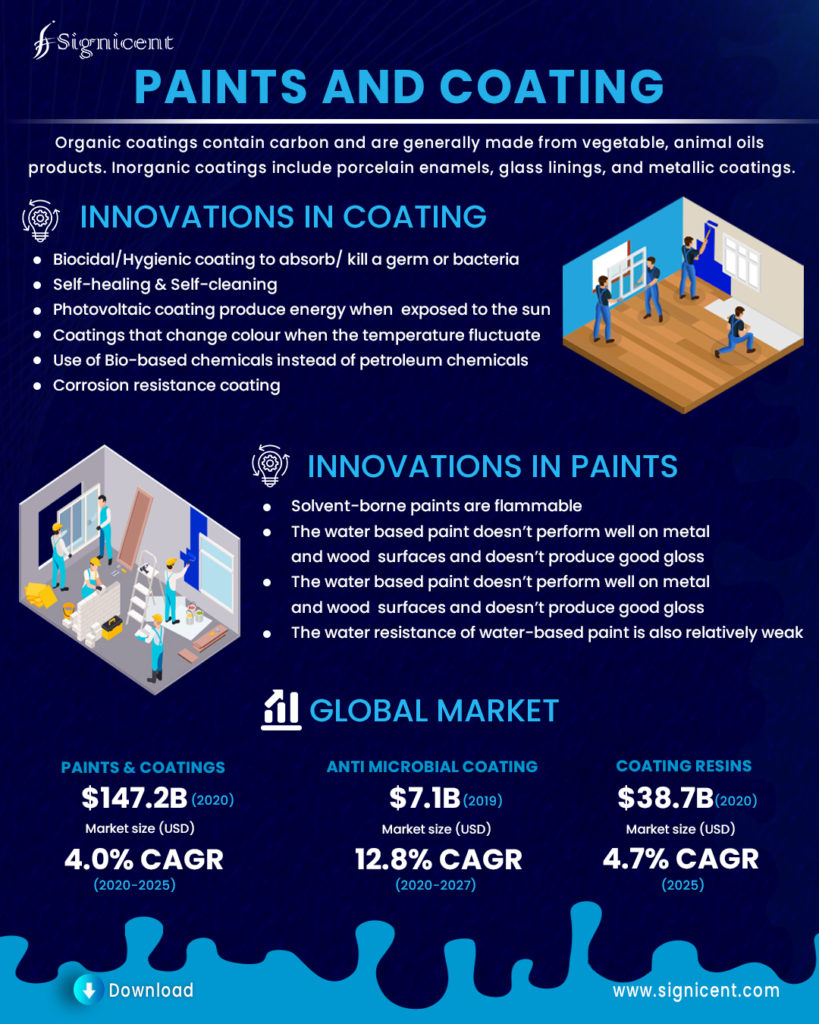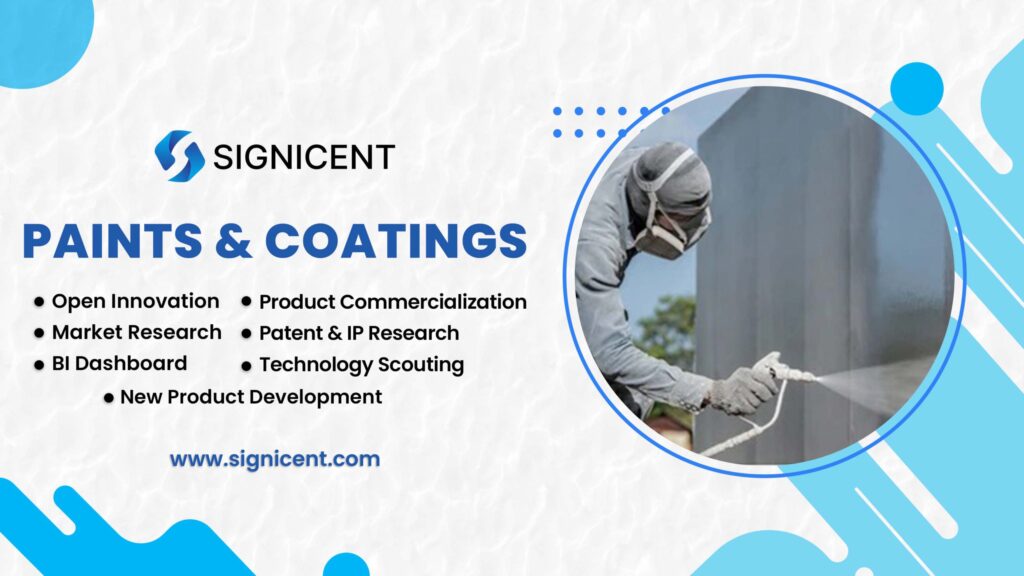Paints & Coating Report describes innovations in paints & coating industry such as antiviral technology, nanotechnology, self-cleaning, eco-friendly coatings. Further the report covers market size, innovative products, startups, global trends, patents & challenges with the paint and coating industry.
Overview of Coatings
Coatings are considered thin and thick films, used for decorative and protective purposes. Organic coatings contain carbon and are generally made from vegetable, animal oils, and modified petroleum products. Inorganic coatings include porcelain enamels, glass linings, and metallic coatings.
Report on Innovations in Coating
- Silver ions have been shown to react with the thiol group in enzymes and inactivate them, leading to cell death.
- Elevated copper levels used in coatings getinside a cell causes oxidative stress
- Antibacterial coatings provide another way of preventing the growth of bacteria
- Biocidal/Hygienic coating to absorb/ kill a germ or bacteria
- Self-healing (healing itself when damaged) & Self-cleaning (cleaning itself when gets dirty)
- Photovoltaic coating that produce energy when they expose to the sun
- Coatings that change colour when the temperature fluctuate
- Use of Bio-based chemicals instead of petroleum chemicals
- Corrosion resistance coating
- Anti-fingerprint coating, Ice-phobic coating & Solar-reflective (Insulation) coating
Emerging Areas in Antimicrobial Coatings
IONPURE is a soluble glass containing anti-microbial metal Ag ions. It maintains transparency when added to PP, PVC, PC, ABS. It exhibits a high heat resistance and high performance at low concentrations. IONPURE is not discolored by compounding and with age, as it can control the speed of releasing metal ions.
LIQUID GUARD®’s antimicrobial coating is functional and made of silicon, which provides 24/7 infection control, especially against Staphylococcus aureus and E. coli. The molecules of the thin film SiO2 coating contained in the formulation are so sharp that microorganisms tear open the cell wall and are thus rendered harmless.
Report on Water Based Paints & Coatings Effective Against Viruses
ALES Shiquy is a water-based paint with slaked lime as its main component for use on new or previously painted interior concrete, mortar, plasterboard, slate panel, vinyl chloride paper acting effectively on viruses including Canine parvovirus, Influenza virus, Vesicular stomatitis virus Bovine popular stomatitis virus.
Nanotechnology Based Coating
Nano-clean is based on the science of nanotechnology. The main component of Nano-clean is silicium, also known as silicon. Cleaning performance is improved by the modification of surfaces at the microscopic level. This creates a surface similar to hardened glass. When silicium is incorporated in a macro-molecular polymer, it is transformed into a highly effective, ultra-thin protective coating suitable for any hard surface.
Self-Cleaning Coating
Signicent studied a self-cleaning coating-based technology. It comprises organic Polydimethylsiloxane (PDMS) polymers and inorganic nano-Calcium carbonate (CaCO3). It can be fabricated easily on the glass panel via spray-method and cured at room temperature. Furthermore, Due to higher capillary pressure and air-pockets of the coating system the coated glass exhibits great anti-fog surfaces as compared to others.
Cold-Spray Technique
Hutasoit et al. developed Sars-CoV-2 (COVID-19) inactivation using the cold-spray technique to generate antiviral copper coating on the existing touch surface.
Swinburne University of Technology has developed Copper-coating fabricated by cold-spray technology by targeting surfaces with SurfaceWise2™ (a quaternary ammonium polymer coating) to reduce the spread of coronaviruses in indoor environments.
Anti-Viral Coating
The University of Arizona has developed a quaternary ammonium polymer coating. We analyzed the patent and it discloses a phosphate radical modified titanium dioxide photocatalytic antiviral coating. The mass percentage of titanium dioxide is 20-100 wt%, and phosphate radicals are 0.001-0.1wt%.
Phosphate radical modified titanium dioxide
Shanghai Institute of Ceramics has prepared microbe-resistant functional coating by using copolymerization of different kinds of resin monomers into matrix resin, & bonding guanidine oligomer.
Bonding resin matrix with guanidine oligomer
Shanghai Fuyuan Plastic Tech co LTD has embedded benzotriazole-loaded mesoporous silica nanoparticles (MSNs) with PDA-decorated. And the outer surfaces exhibit superior anti-corrosion effects on the damaged areas.
Polydopamine-Coated Nanocontainers
Qingdao Agricultural University and Zhang et al has made self-healing coatings with epoxy ester introduced to coatings working as a healing agent. PDF-epoxy ester microcapsules were synthesized by two-step polymerization, & micro-cracks were healed by a new layer.
Microcapsules containing epoxy ester
The University of Akron has developed self-cleaning interior and exterior wall coating of buildings comprising SiO2 sol, anatase TiO2 nanometer powder, glacial acetic acid, a film-forming agent, and water.

Report on Overview of Paints
Water-based paints are manufactured with water as their ‘solvent’. They are thinned, can be cleaned up with water, also safer to use, and has a lower odor. water-based products can include epoxies, polyurethane, acrylics, and more.
Solvent-based paints are a little trickier contain a solvent generally hazardous and higher in odor. The selection of thinner to dilute is extremely important for performance. They offer advantages in lower temperatures with required chemical resistance or fast curing times.
Innovation in Paints
To get comprehensive paint and coating report, click here. In the field of paint, endless innovations are happening, some of them are listed below :
- The water resistance of water-based paint is also relatively weak
- Water-based paint thermal stability and water resistance is poor, that affects the performance of the coating
- The water based paint doesn’t perform well on metal and wood surfaces and doesn’t produce good gloss.
- Solvent-borne paints are toxic and has negative environmental impact Hydrocarbon solvents refer to volatile organic compounds (VOCs, evaporate fast and enter human body in the fumes forms)
- Solvent-borne paints are flammable (has low flash point and autoignition point)
Emerging Areas in Paints
An opaque, waterborne exterior wood protection coating with very good color stability and long maintenance cycles. It contains fungicides and high content of pigments protects the woodwork against fungus and UV damages and gives a very good shield against the weather.
Emerging Areas In Smart Paints
The composition is a novel bio-based liquid-repellent coating with 2-mercaptoethanol-modified castor oil (COME) as a coating precursor, with striking anti-ink ability and self-cleaning performance.
Wall, a low-cost sensing approach that allows walls to become a smart infrastructure that can track users’ touch and gestures, as well as estimate body pose if they are close. The basic principle of Wall sensing relies on patterning large electrodes onto a wall using conductive paint.
Report on R&D in the field of Paints & Coating
Bio-Functional/ Based Components
- Replacing Petroleum-derived chemicals with natural oils like vegetable oils.
- Making the compositions less volatile.
- Functional additives(enzymes, peptides etc.)
Eco-friendly binders
- Use of casein as renewable resource.
- Acrylic-casein latexes
- High performance waterborne coatings.
- No need for emulsifier
Miscellaneous
- Powder Based Paints
- Solvent Free Paints
- Resistance from Physical, chemical and biological abrasions
Report on Nanoparticle technology in Paints & Coating
- Waterborne nano-hard-spheres
- Boosted the performance of coatings
- Decorative and industrial purposes.
Potential Players in R &D
The following key players are driving the market as they are incorporating innovations.
Rustoleum has made Noxyde which provides ultimate corrosion protection. Its 200 % elastic coat never cracks or peels off. The Noxyde is UV and impact-resistant. The product Apoclite and Epoxy121 aids in rust busting.
Sherwin Williams has an amazing technology termed ColorSnap that allows the customer to explore available colors and virtually paint any room with the swipe of a finger. Additionally, the customer can match colors from photos, save colors and virtually paint the walls before making any purchase decision.
PPG’s Color Nix tool offers to match with over 200,000 paint colors. They have chip technology too to pick the perfect color. The Nix + Chip gives the perfect blend of innovative technology and color matching.

Impact of COVID-19 On Major Companies in Paints & Coating Report
- Net sales decreased $273.8 million, or 5.6%, to $4.60 billion in the quarter
- Net sales down 25%, to $3.0 billion
- Increased Due to do-it-yourself [DIY] demand of PPG paint products
- The company’s Q4 results show 14% year-on-year decline.
- The saving grace was lower raw material costs with crude oil prices scraping the barrel.
- Decline in sales by 8.9% for the quarter.
- Number of plants temporarily closed.
- 43% fall in revenue (Apr-Jun)
- Benefited from a sharp fall in raw material/trading stock expenses
- Sales decreased 12.1% year-over-year.
- With-drawing previous financial guidance for 2020
Report on Regulatory Authorities in Paints & Coating

Market Research Report on Paints & Coating
- Paints & coatings market size is projected to grow from USD 147.2 billion in 2020 to USD 179.4 billion by 2025, at a CAGR of 4.0 %.
- Global anti-corrosion coating market size valued at $22.8 billion in 2019, and is projected to reach $41.2 billion by 2027, growing at a CAGR of 8.3% from 2020 to 2027.
- Global antimicrobial coatings market size was valued at USD 7.1 billion in 2019 and is expected to grow at a CAGR of 12.8% from 2020 to 2027.
- The global self-healing materials market size was estimated at USD 291.4 million in 2018, growing at a CAGR of 46.1% from 2019 to 2025.
- Global coating resins market is projected to grow from USD 38.7 billion in 2020 to USD 48.8 billion by 2025, at a CAGR of 4.7%.
- Powder Coatings Market size is expected to grow from $15.0 billion by 2026, at a CAGR of 5.4% during the forecast period 2019-2026.
Recent Reports
- Future of Cooking with Nanotechnology: How Smart Kitchen Technology Is Transforming Modern Kitchens
- The Hidden Genius Behind Your Devices – Gurtej Singh Sandhu’s Innovations That Fuel Our Digital World
- Hydrogen Fuel Cells — Powering a Cleaner Future of Energy & Mobility
- Antibacterial & Antiviral Technologies for Personal and Home Care
- Why Waterless Beauty Innovations Are the Next Big Thing in Skincare


